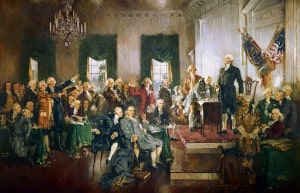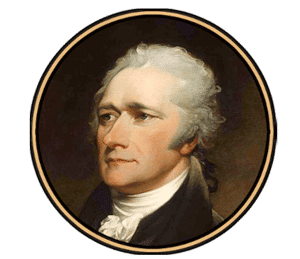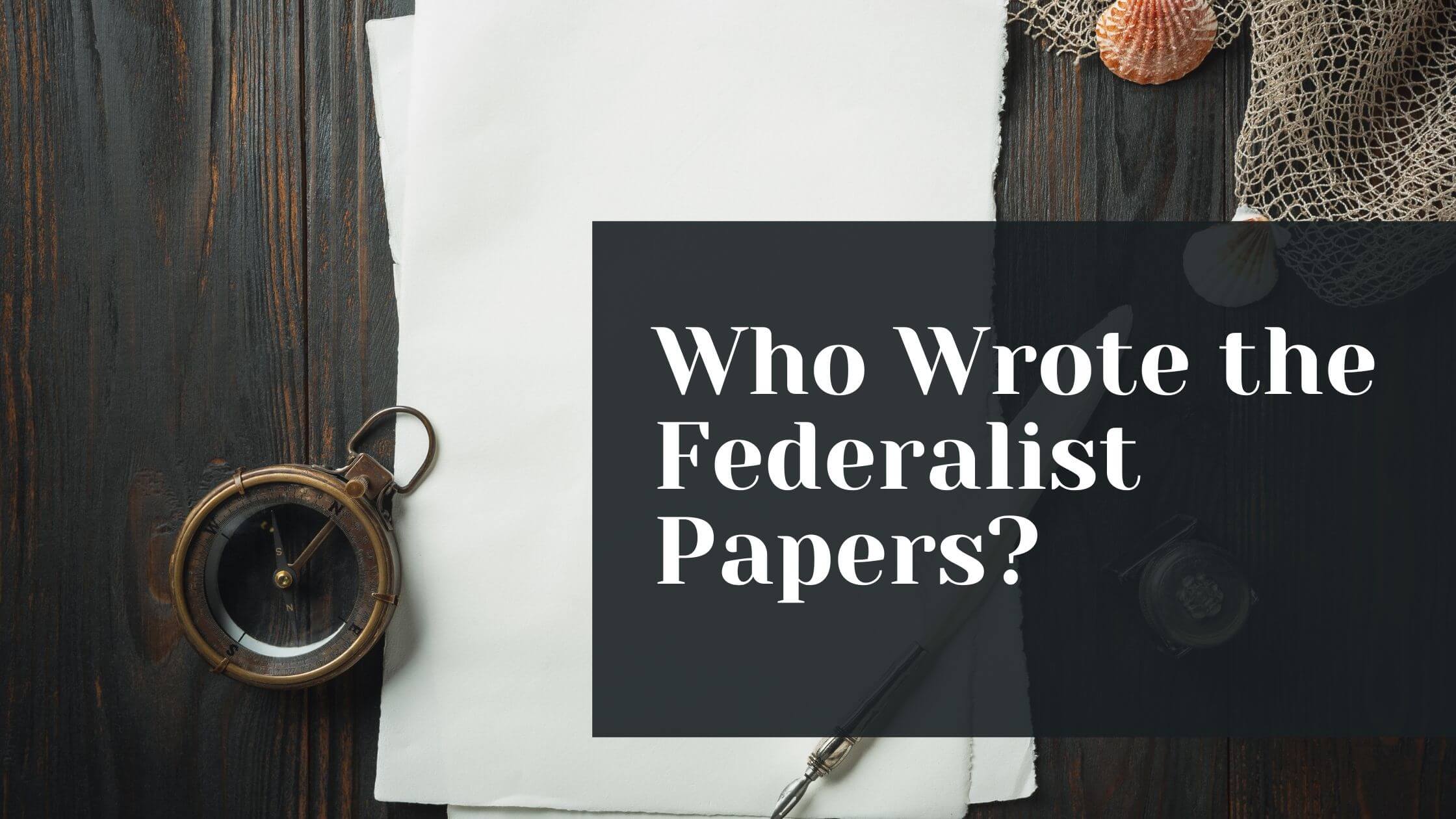Table of Contents
ToggleWhat Was the Aim of the Federalist Papers?
The Federalist Papers were a series of essays published between October 1787 and May 1788. Their goal was to convince New Yorkers to support the new United States Constitution.
Written by Alexander Hamilton, James Madison, and John Jay, the essays explained why a stronger federal government was necessary and how it would protect liberty, not threaten it.
While not everyone agreed, the papers helped shape public opinion and played a key role in the Constitution’s ratification.
Authors of the Federalist Papers
The Federalist Papers were not the work of a single author but rather a group of men acting together to put forth convincing arguments in favor of the Constitution. Alexander Hamilton, James Madison, and John Jay created an impressive number of installments for the people of New York to help them see the value in the Federalist way of thinking.

Get Smarter on US News, History, and the Constitution
Join the thousands of fellow patriots who rely on our 5-minute newsletter to stay informed on the key events and trends that shaped our nation's past and continue to shape its present.

Hamilton and Madison were prominent figures at the Constitutional Convention in Philadelphia, where the new Constitution was drafted. In collaboration with Jay, they produced a collection of work that is still revered as a key historical document in the evolution of the United States.
Who Was Publius?
Initially, Hamilton, Madison, and Jay preferred to remain anonymous and used a pseudonym for their publications. It made sense for the three writers of these famous essays to retain their anonymity, allowing the writing to speak for itself. Readers might not have given as much attention if they knew who the authors were.
The name “Publius” came from Publius Valerius Publicola, a Roman statesman known for helping to found the Roman Republic. The authors chose it as a symbol of opposition to tyranny.
At the same time, this sort of shared identity meant that it wouldn’t have been immediately clear who wrote which piece. There were differences in style and message to a point, but it remained a group effort with a common goal. What’s more, there was a high level of secrecy around creating and ratifying the constitution, where many documents were destroyed.
The pen name adopted, Publius, was a nod to a key figure involved in founding the Roman Empire, Publius Valerius Publicola. It appears that Hamilton saw something of himself and his peers in Publius. The name stuck and was attached to the essays in their serialized form, and the bound version was created in 1788.
The Authors’ Roles in the Creation of the Constitution
The need for the Federalist Papers came about from the creation of the Constitution during the Constitutional Convention in Philadelphia in 1787. Delegates from across the 13 states – with the exception of Rhode Island – descended on the city for months of debates. The current Articles of Confederation were not fit for purpose and required practical adaptations to serve the nation better. The result was an entirely new United States Constitution. This was passed to Congress for approval before the requisite ratification process.
The three members of Publius were ardent Federalists who supported the need for a more centralized form of government. But, there were plenty of Anti-Federalists who weren’t keen to sign. The Federalist Papers gave the authors the chance to defend the ideas within the proposed constitution and explain why the original Articles of Confederation had to change.
The writers began their series of essays in October of 1787, not long after the Constitution was sent out for ratification. Their target was New York, a vitally important state because of its population and wealth, and one the United States couldn’t afford to lose.
The papers became a series in two leading newspapers for all to read in the hope of swaying the state and speeding up the ratification process. This turned into a long-running series of essays with 85. As the essays continued to be published, many states signed, and the document achieved the majority needed for ratification, but the remaining states held out.
Alexander Hamilton and the Federalist Papers
The man most famous for his role in the creation of the Federalist Papers was Alexander Hamilton, who led the project in multiple capacities. It was his idea to create the series to advocate for the new constitution. He was also responsible for bringing in the other two participants, creating the Publius pseudonym, and penning the majority of the essays in the series.

Interestingly, he is said to have had little influence at the Constitutional Convention compared to Madison. He also held strong opinions on centralized government and a preference for British models that didn’t go down well with other delegates. Yet, he eventually found his way onto the Committee of Style and Arrangement with William Samuel Johnson, Gouverneur Morris, James Madison, and Rufus King.
Hamilton was a Delegate to the Congress of the Confederation from New York before becoming Secretary of the Treasury under President George Washington in 1789. He worked on the creation of the central bank and the nation’s war debts.
Was Hamilton the Most Influential Contributor?
It is widely accepted that Alexander Hamilton wrote 51 of the 85 essays. The pieces were often split into themes, allowing the authors to continue developing ideas and writing more persuasive arguments about key areas of the Constitution. Hamilton was also responsible for the opening piece and the all-important Federalist 84 that discussed the Bill of Rights.
It should be noted that when the papers were first compiled as a bound edition under the Publius name, Alexander Hamilton oversaw the edits and corrections. This suggests a keen desire to create the most persuasive and accurate portrayal of their argument right to the end.
Federalist 84 and the Bill Of Rights
Despite the best efforts of Publius to prove their point, there was still discontent among Anti-Federalists in the states yet to ratify the Constitution. They weren’t convinced about signing away the rights and freedoms of their people by giving a centralized federal government more power. Their proposal was simple. They wanted a Bill of Rights.
This was an idea tabled during the Constitutional Convention but disregarded by the final framers. They deemed it unnecessary when there were strong clauses about citizens’ freedoms and unwritten rights. Alexander Hamilton was strongly opposed to the Bill of Rights and detailed his arguments in Federalist 84.
Despite all this, the Federalists eventually had to concede and give assurances that Congress would work on a Bill in its first session. This convinced New York and other resistant states to ratify the document. An interesting note here is that Publius member Madison was influential in creating the Bill of Rights in his new role in Congress in 1789.
The Role of James Madison
Alexander Hamilton wanted to bring in the best possible writers for the job, and he chose James Madison and John Jay. James Madison is a name we know well as a later President of the United States. Following the creation of the Federalist Papers, he would also become a member of the United States House of Representatives from Virginia, serve as Secretary of State under Thomas Jefferson, and finally become President in 1809.

Despite his links to Virginia rather than New York, like the others, Madison was an ideal fit for the role. He was a passionate Federalist keen to express his opinions and the man with the longest involvement in the constitutional process. He arrived in Philadelphia eleven days before most other delegates, with speeches prepared, and was eager to set the convention’s agenda as it progressed.
Madison wrote 29 of the 85 essays. In Federalist No. 10, he explained how factions naturally form in society and why a large republic could best control their effects. In Federalist No. 39, he described the United States as a mix of federal and national principles. His writings helped define the balance of power between the national and state governments.
The Lesser-Known John Jay
John Jay is perhaps the least well-known of all of the writers of the Federalist Papers despite his political acumen. His compatriots had a stronger say in the creation and final draft of the Constitution, but Jay had an abundance of political experience.
He was not as heavily involved in the scheme as his peers due to health issues, having developed rheumatism, which impeded his writing ability. He started strong, writing the second, third, fourth, and fifth on the subject of “Dangers from Foreign Force and Influence.” He then returned to write Federalist 64 on the role of the Senate in the creation of foreign treaties.
Before the Constitutional Convention in Philadelphia, Jay had been influential in the First and Second Continental Congress. He was president of the latter for a year before becoming the United States Minister to Spain, Secretary of Foreign Affairs, Acting Secretary of State, Governor of New York, and then the first Chief Justice. Again, a strong New York connection is significant to his role in Publius.
Jay wrote only five of the essays because of illness. His work focused on foreign threats and the need for a unified national government to handle international relations.
Was Gouverneur Morris an Author of the Federalist Papers?
There is a fourth figure that risks being forgotten in relation to the Federalist Papers. While Gouverneur Morris was not one of the contributing authors to the serialized essays, Hamilton considered him for the role. This comes as no surprise, considering his influence at the Constitutional Convention. He would have been a good fit for the Publius collective because of his political knowledge and links to New York. Later, he would act as the United States Minister to France and Senator for New York.
Morris is one of the most important founders related to the creation of the Constitution and was responsible for writing the preamble. His signature can be found on the Constitution and the Articles of Confederation that preceded it. He introduced the idea of the people becoming citizens of the United States rather than their respective home states. He was also highly influential at the Constitutional Convention, making more speeches than any other delegate.
When Were the Identities of the Authors Revealed?
For quite some time, nobody knew who was behind the Publius name, and the writers kept that secret long after the ratification of the Constitution. The bound collection of papers retained the pseudonym to protect their identities and further the cause in its first edition. The names weren’t officially revealed until decades later, with a new edition in 1818. Madison amended this version, and the decision was made to attribute the work to its true authors.
In doing so, they cleared up the mystery and made the publication more interesting. Historians could now see which author focused on which subject, the language used, and the ratio of pieces written. Hamilton would not live to see this or any praise for his work, as he died in 1804.
The attributions on the documents also highlight the initial importance of the pseudonym. There is some dispute over exactly who wrote what. While Hamilton is now credited with 51 of the 85, asterisks by his name indicate where it is believed he had assistance from Madison.
Madison would challenge the idea that he was only responsible for 29 because of these contributions. Had the trio kept their names in place instead of working as the Publius collective, there might have been more infighting and issues reaching that grand total of 85.
The Legacy of the Federalist Papers Writers Today
The work of these three men, with their questionable attributions, is still available to view online. You can see how these men argued for their case and detailed the need for a shift from the Articles of Confederation to the new constitution. However influential the essays were at the time, there is no doubt that they hold an important place in American history today.











One Response
Isn’t American history interesting and fascinating! Unlike today back then people were reasonable and actually debated with open minds to all views with both ears left and right. People were thinkers and didn’t form unmovable armies against each other’s opposite view. No matter what the consequences, driving an opinion to a shallow grave, finding revenge is only sweet when it happens to the other persons debated idea. “Follow the money to people or states or groups, usually dominates the issues involved. It happens at all levels private and personal, city, state or federal. The chief protagonist are greed, money, control and power. Next time something happens as “why” and what favor required.